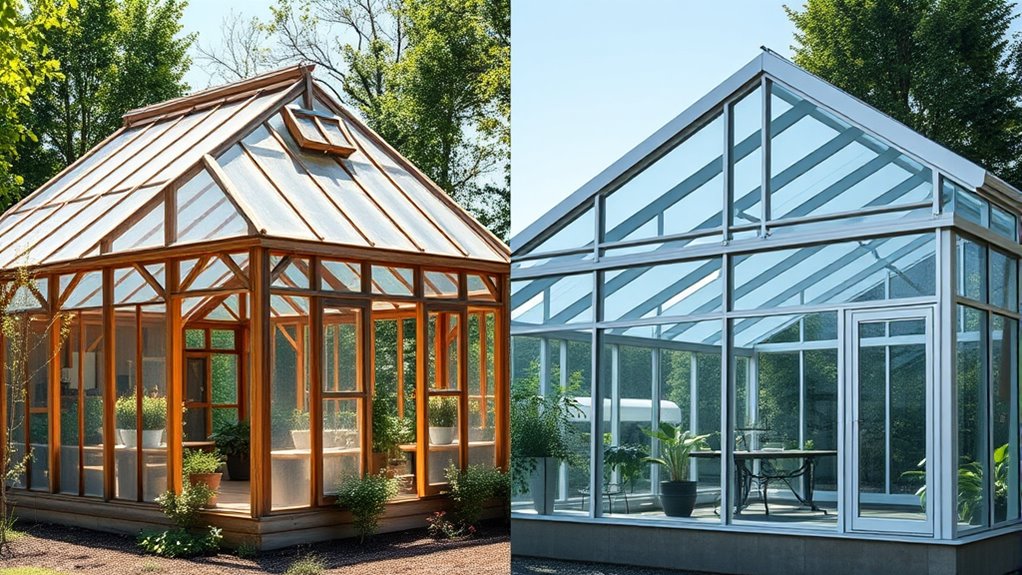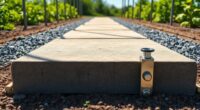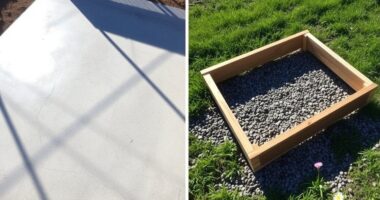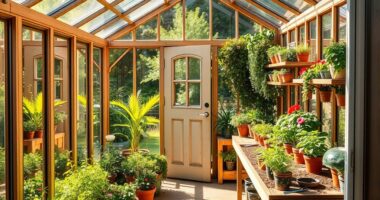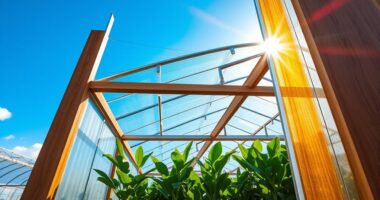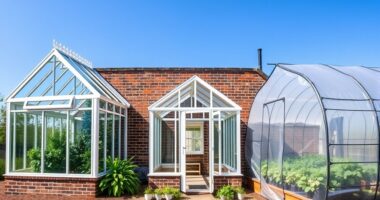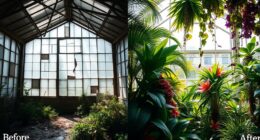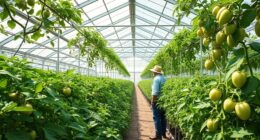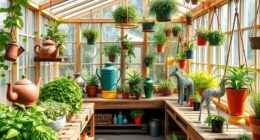Choosing between DIY and pre-fab greenhouses comes down to your budget, customization needs, and time. DIY options are cheaper initially and let you personalize size and features, but they demand more time, effort, and skills, with possible repairs down the line. Pre-fab models cost more upfront but offer quick setup, durability, and less maintenance. To find out which suits your gardening goals best, explore the full comparison next.
Key Takeaways
- DIY greenhouses offer customization and lower initial costs but may require more time, skills, and maintenance.
- Pre-fab models are faster to assemble, more durable, and generally need less ongoing repair or upkeep.
- Material quality impacts longevity: DIY options vary with material choices, while pre-fab structures use resilient, weather-resistant materials.
- DIY builds allow design flexibility and future expansion, whereas pre-fabs typically have limited customization but provide quick, reliable setup.
- Consider climate, space, and budget to choose between the cost-effective, personalized DIY approach or the durable, low-maintenance pre-fab solution.
Cost Comparison Between DIY and Pre-Fab Greenhouses
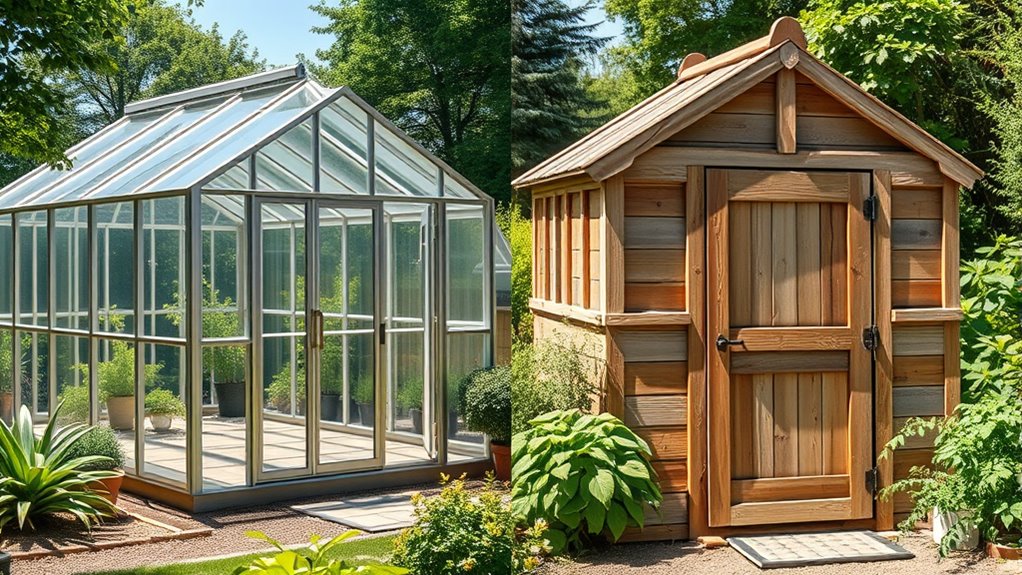
When comparing the costs of DIY and pre-fab greenhouses, you’ll find that initial expenses can vary considerably. With DIY options, material choices like PVC, wood, or recycled materials affect costs, often making it more affordable upfront. You can select budget-friendly materials, but quality and durability might differ. Pre-fab greenhouses tend to have higher initial costs, mainly because of factory-made components and standardized designs. However, their aesthetic appeal often looks sleek and professional, adding visual value to your garden space. While DIY builds can be functional and charming, pre-fab options usually offer a more polished appearance. Additionally, the materials used in construction can influence the long-term maintenance costs and overall durability of the greenhouse. Ultimately, your budget and desired look influence whether you opt for the more customizable, potentially cheaper DIY route or the ready-made, aesthetically refined pre-fab greenhouse.
Customization and Design Flexibility
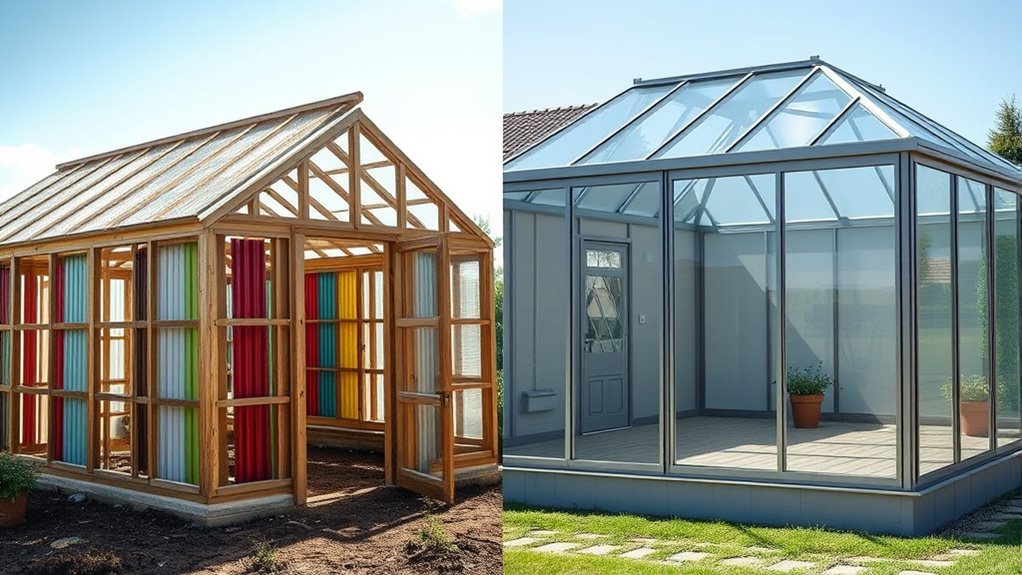
Customization and design flexibility vary considerably between DIY and pre-fab greenhouses. With DIY options, you have greater control over design customization, allowing you to tailor the structure to your specific aesthetic preferences. You can choose materials, shapes, and features that match your yard or style, enhancing aesthetic versatility. Additionally, tuning options for greenhouses can include selecting specific features like venting systems or shelving configurations to better suit your gardening needs. DIY greenhouses often allow for more innovative construction techniques, enabling you to create a structure that truly reflects your personal vision. Moreover, the ability to select specific building materials ensures that your greenhouse not only meets functional requirements but also aligns with your aesthetic goals. This level of customization can also help you incorporate supergrain-based features or other sustainable elements to further personalize your space. You can also experiment with lighting setups to optimize plant growth and ambiance. Pre-fab greenhouses, on the other hand, often come with limited options, focusing on functionality over customization.
Key points include:
- Ability to modify size and shape easily
- Incorporation of personalized design features
- Choice of materials for aesthetic appeal
- Flexibility to add custom accessories
- Enhanced aesthetic versatility for unique garden visions
Ease of Construction and Assembly
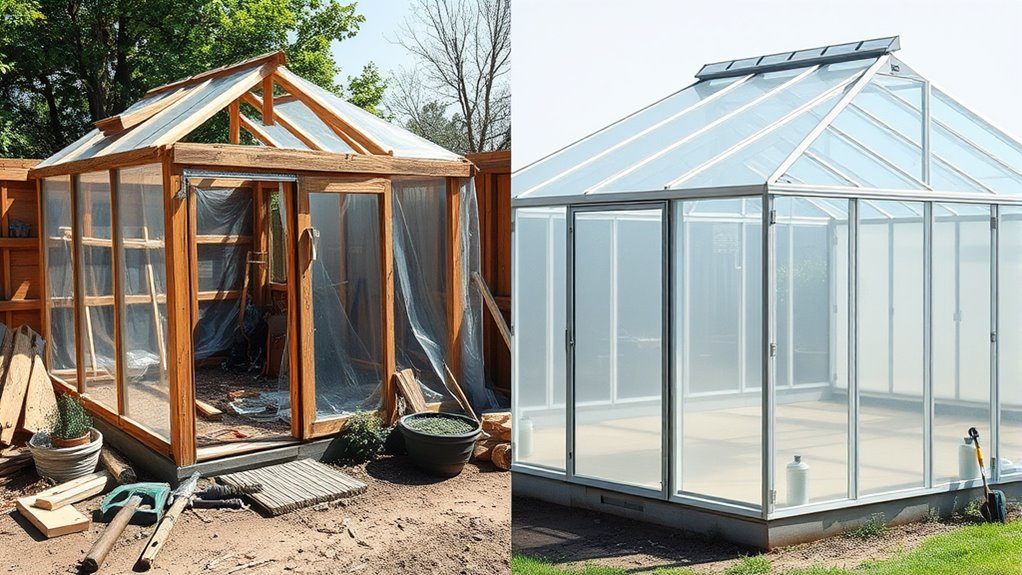
When it comes to building a greenhouse, the assembly process varies greatly between DIY and pre-fab options. You’ll need to contemplate how complex the setup is, what tools and skills are required, and how much time you’ll need to complete it. Understanding these factors helps you choose a solution that matches your experience and schedule. Additionally, considering the ease of setup can influence your overall satisfaction with the project. For some, factory-made structures may be appealing because they often come with detailed instructions and standardized parts for quicker assembly. Moreover, traditional craftsmanship in handmade structures can offer unique benefits, although it might require more time and skill to assemble correctly. Incorporating sound healing science principles into your greenhouse design could also enhance the overall environment, promoting relaxation and well-being for users. Furthermore, selecting a design that supports modular construction can make future expansion or adjustments easier and more cost-effective.
Assembly Complexity Levels
Assembly complexity varies considerably between DIY and pre-fabricated greenhouses, influencing how easily you can set up each option. DIY models often require more time and effort due to tasks like frame anchoring and aligning components. Pre-fab greenhouses are designed for straightforward assembly, often with detailed instructions and fewer steps. Additionally, cost considerations play a significant role in choosing between the two, as DIY options may incur lower upfront costs but demand more time and effort. Key factors impacting complexity include: – Ease of installing ventilation options – Handling and attaching framing components – Securing panels and joints – Adjusting for proper frame alignment – Integrating ventilation and frame anchoring systems. Preparation and planning are crucial to ensure a smoother assembly process, especially for DIY projects. Proper understanding of growing conditions can also influence the design choices for your greenhouse, affecting how you approach assembly. Moreover, available tools and resources can significantly impact the ease of construction, making some projects more manageable than others. Pre-fab units typically streamline these steps, reducing the challenge. DIY options demand patience and precision, especially when ensuring stable frame anchoring and ideal ventilation setup. Your choice influences the overall assembly effort and timeline.
Required Tools and Skills
Constructing a greenhouse requires a specific set of tools and skills, and the ease of assembly varies considerably between DIY and pre-fabricated options. With DIY greenhouses, you’ll need basic handyman skills and familiarity with power tools like drills, saws, and screwdrivers.
Precise measurements and assembly are essential, so patience and attention to detail matter. Pre-fab greenhouses, on the other hand, are designed for straightforward assembly, often requiring only common hand tools and minimal technical skills.
If you’re comfortable using power tools and following detailed instructions, building a DIY greenhouse is feasible. However, if you lack handyman skills or prefer a faster setup, pre-fab options simplify the process, reducing the need for advanced skills and making assembly accessible to most beginners.
Time Investment Needed
Building a greenhouse can vary considerably in time commitment, depending on whether you choose a DIY or pre-fabricated model. Pre-fab greenhouses typically have a faster assembly speed, reducing your overall construction duration. You can expect to assemble these in less time, often over a weekend or a few days, with clear instructions.
In contrast, DIY models require more planning and manual effort, extending the construction duration. Keep in mind:
- Pre-fab kits offer quick assembly
- DIY projects demand more time for customization
- Clearer instructions speed up pre-fab setup
- Skill level influences DIY construction speed
- Overall, pre-fab greenhouses minimize time investment
Choosing between the two depends on your schedule and patience, but pre-fab options generally save you significant time.
Material Quality and Durability
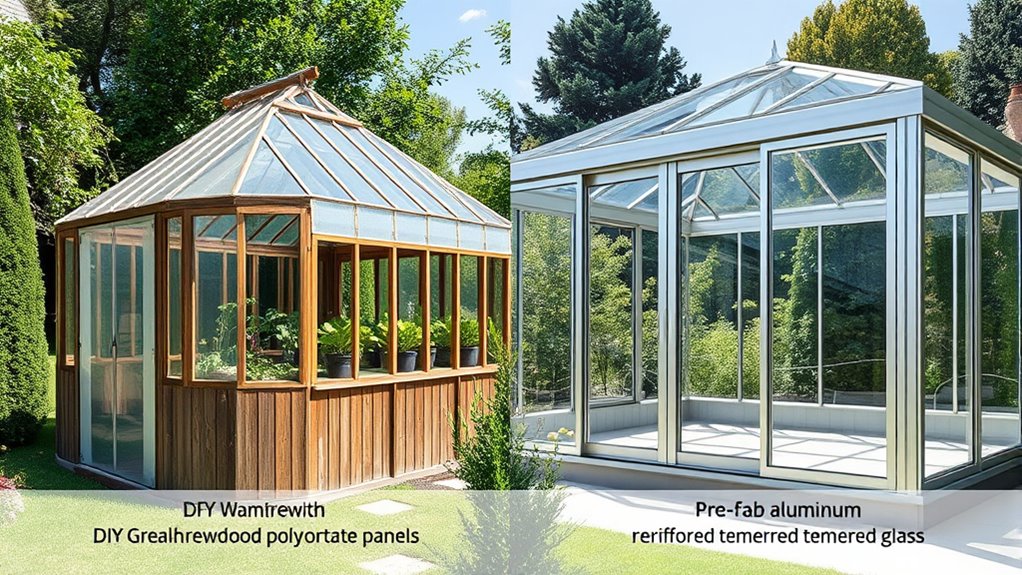
Material quality and durability are critical factors that can determine how long your greenhouse lasts and how well it performs over time. High material strength ensures your structure can withstand daily stresses and potential impacts, giving you peace of mind. Using high-quality materials can reduce the risk of structural failure and ensure your greenhouse remains functional for years. Weather resistance is equally important, as your greenhouse will face various elements like wind, rain, and snow. Pre-fab models often use durable materials designed for long-term resilience, while DIY options may vary depending on your choices. Selecting quality materials means fewer repairs and replacements down the line, saving you money and effort. Keep in mind that investing in sturdy, weather-resistant components can extend your greenhouse’s lifespan and maintain excellent conditions for your plants. Considering material durability in your selection process helps ensure long-lasting performance and reduces the need for frequent repairs. Ultimately, choosing well-made materials is key for a reliable, lasting greenhouse.
Time Investment and Construction Speed
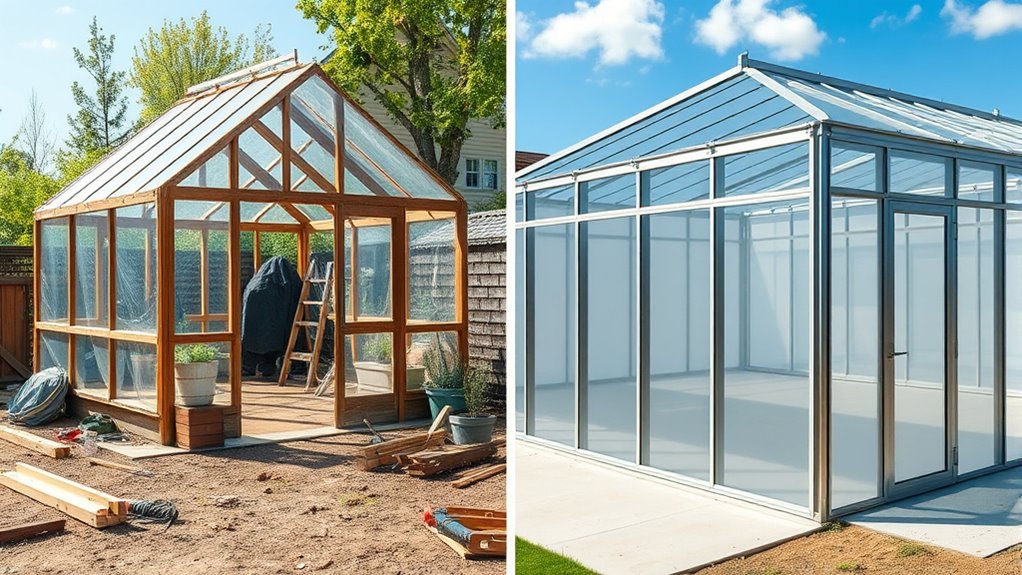
When considering how quickly your greenhouse can be up and running, time investment plays a considerable role. Pre-fab greenhouses generally offer faster assembly speed, reducing your construction timeline markedly. With pre-fab options, you can expect:
- Minimal site preparation
- Clear, step-by-step instructions
- Fewer tools needed
- Shorter overall build time
- Reduced labor effort
Additionally, pre-fab greenhouses often incorporate pre-assembled components, which streamline the assembly process and minimize delays caused by custom fabrication. DIY greenhouses often require more time due to custom building, sourcing materials, and potential troubleshooting. The construction timeline can stretch over days or even weeks, depending on your experience. Additionally, permits and inspections can add to your timeline if not completed beforehand. If speed and efficiency are priorities, pre-fab solutions save you valuable time. However, if you enjoy a hands-on project and customization, DIY may extend your timeline but offer a more personalized result. Additionally, choosing cost-effective materials can influence both the speed of construction and the overall budget.
Maintenance and Longevity
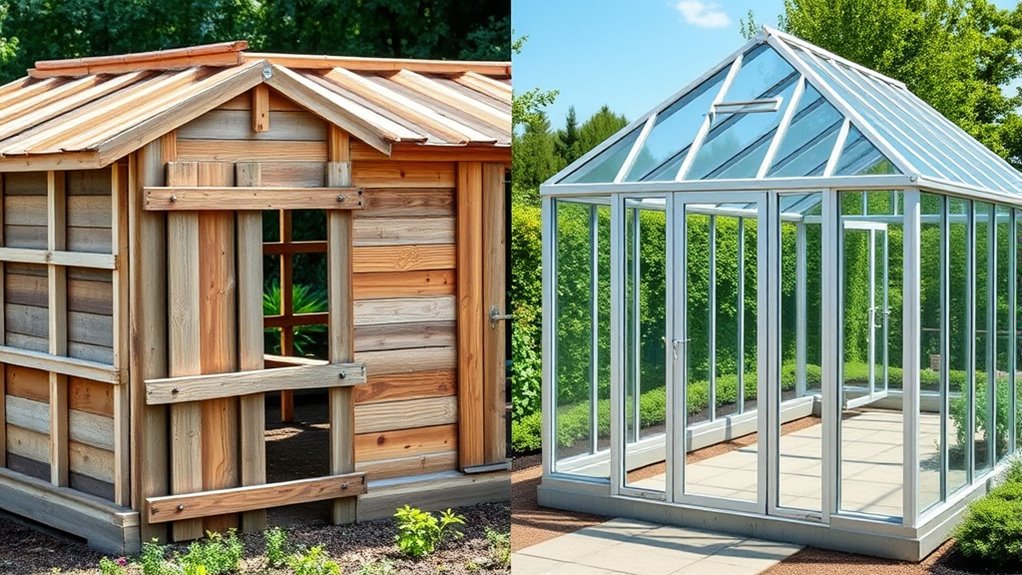
Your greenhouse’s durability affects how often you’ll need repairs and how long it lasts.
Pre-fab models often come with stronger materials that require less maintenance, while DIY setups might need more frequent fixes.
Considering ease of upkeep can help you choose a design that fits your ability and keeps your greenhouse in top shape.
Durability and Repairs
While both DIY and pre-fab greenhouses can last for years with proper care, their durability and ease of repairs often differ. Material strength plays a key role in how well your greenhouse withstands weather and wear.
DIY models may use less durable materials, leading to higher repair costs over time. Pre-fab structures typically feature stronger materials and better engineering, reducing the frequency of repairs.
However, when repairs are needed, DIY greenhouses might be easier to fix yourself but could require more time and effort. Pre-fab options often involve professional repairs, which can be more expensive but more reliable.
Consider these points:
- Material quality impacts durability
- Repair costs vary between DIY and pre-fab
- Pre-fab structures tend to be more resilient
- DIY repairs may be simpler but less durable
- Long-term investments influence repair needs
Ease of Upkeep
Maintaining a greenhouse efficiently depends largely on its design and materials, affecting how much time and effort you’ll need over its lifespan. Pre-fab greenhouses often offer better climate control features, making temperature regulation easier and reducing maintenance. They typically come with sealed joints and durable materials that resist wear and pests, simplifying pest management.
DIY options may require more frequent repairs and adjustments to maintain ideal conditions, especially if materials aren’t as weather-resistant. Longevity also varies; pre-fab models are built for durability, meaning less ongoing upkeep. In contrast, homemade structures might need regular repairs, affecting their lifespan.
Adaptability to Different Climates and Spaces
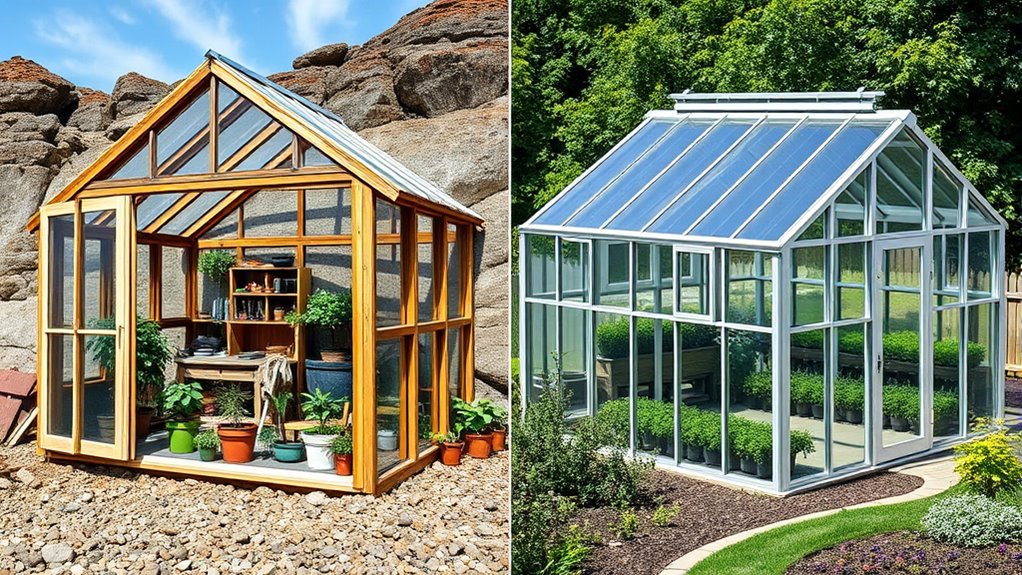
Both DIY and pre-fab greenhouses offer varying degrees of adaptability to different climates and spaces, but their suitability largely depends on your specific environment. Climate adaptability influences how well your greenhouse withstands temperature fluctuations, wind, and humidity.
Pre-fab models often excel in spatial flexibility, fitting into smaller or irregular spaces with ease. DIY options can be customized to suit unique climate challenges but may require extra effort.
Consider these points:
- Material selection for temperature regulation
- Structural design for wind resistance
- Size options to match available space
- Ventilation and insulation capabilities
- Modular features for easy expansion or modification
Choosing the right type ensures your greenhouse performs efficiently in your climate and fits seamlessly into your available space.
Overall Suitability for Different Gardening Goals
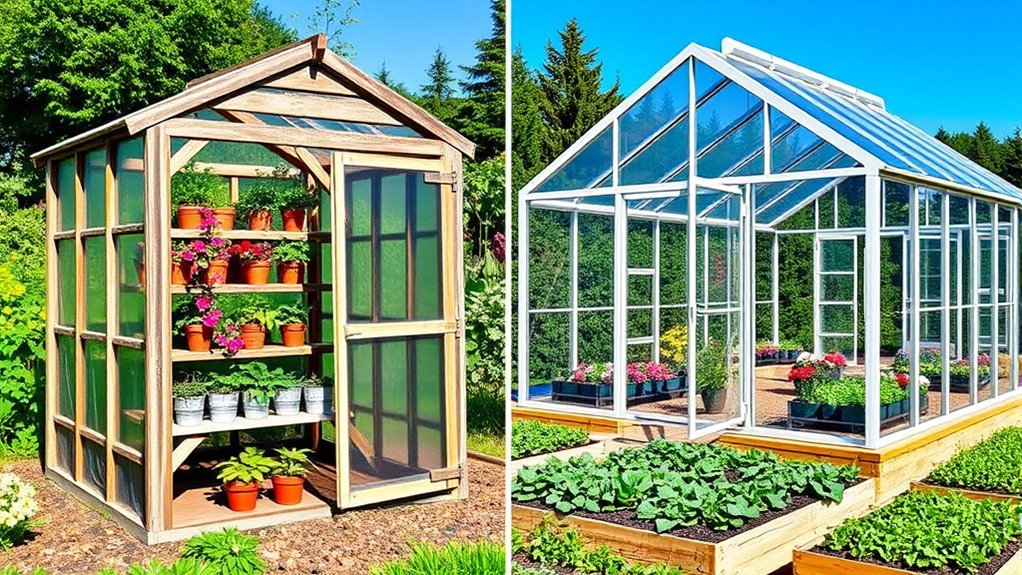
Your choice between DIY and pre-fab greenhouses largely depends on your gardening goals.
Choosing between DIY and pre-fab greenhouses depends on your gardening goals.
If you’re aiming to optimize plant growth, pre-fab options often provide better insulation and climate control, making them ideal for delicate or exotic plants. They’re designed for consistency and can support year-round gardening.
On the other hand, if aesthetic appeal is a priority, a DIY greenhouse allows you to customize design and materials, creating a structure that complements your outdoor space. DIY greenhouses often offer unique styles that enhance your garden’s visual appeal.
Consider your specific needs—whether you want to maximize plant growth efficiency or create a visually stunning garden feature—to determine which type suits your goals best. Each approach can help you achieve different gardening outcomes.
Frequently Asked Questions
Which Greenhouse Type Offers Better Insulation for Extreme Weather?
You’ll find that the greenhouse type with better insulation for extreme weather depends on insulation effectiveness and climate resilience.
Pre-fab greenhouses often feature superior insulation materials and construction, providing better protection during harsh conditions.
DIY options can be customized for improved insulation, but mightn’t match the consistent quality of pre-fab structures.
Ultimately, pre-fab greenhouses typically offer enhanced climate resilience, making them more reliable in extreme weather scenarios.
Can DIY Greenhouses Be as Environmentally Sustainable as Pre-Fab Options?
Did you know that over 75% of greenhouse materials can be recycled? When considering sustainability, DIY greenhouses can match pre-fab options by using recycled materials and incorporating renewable energy systems.
You have the flexibility to choose eco-friendly supplies, reducing waste and carbon footprint. So, with careful planning, your DIY greenhouse can be just as environmentally sustainable, empowering you to create a greener, more sustainable gardening space.
Are Pre-Fab Greenhouses Easier to Upgrade or Expand Later?
Pre-fab greenhouses generally offer better modular flexibility, making upgrades or expansion easier later. You can add sections or change configurations without significant structural challenges.
DIY greenhouses might require substantial modifications and can face structural challenges when expanding, especially if built on a smaller scale initially.
How Do Costs Compare Over the Long Term for DIY Versus Pre-Fab?
You might find that over the long term, DIY greenhouses can be more cost-efficient initially since you control materials and labor costs. However, maintenance costs could be higher if you lack experience, leading to potential repairs or upgrades.
Pre-fab greenhouses often have higher upfront costs but tend to be more durable and require less maintenance, which could balance out expenses over time.
Consider your budget and skills for the best long-term investment.
What Safety Considerations Are Involved in Constructing a DIY Greenhouse?
You might find yourself immersed in constructing your DIY greenhouse, but safety should come first. Guarantee electrical safety by properly grounding outlets and wiring, avoiding shortcuts that could cause shocks or fires.
Pay close attention to structural integrity—use sturdy materials and secure joints to prevent collapse.
Always wear protective gear, follow local building codes, and double-check your work to create a safe, durable environment for your plants and your family.
Conclusion
Choosing between DIY and pre-fab greenhouses depends on your budget, skills, and gardening goals. DIY offers customization and cost savings but demands time and effort, while pre-fabs provide quick setup and consistent quality. Remember, “a journey of a thousand miles begins with a single step.” Whichever option you pick, make certain it fits your space, climate, and vision. With patience and care, your greenhouse will flourish just like a well-tended garden.
